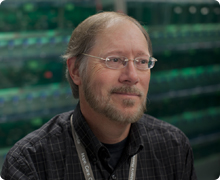Therapies for Controlling Fibrosis and Scar Tissue Formation
Acomys: A natural mammalian model of regeneration
Technology Overview
 Dr. Mark Majesky
Dr. Mark Majesky
Fibrosis – the formation of a connective tissue patch or scar in response to inflammation or injury – is involved in a number of pathologies. Fibrosis is at the root of chronic kidney disease, cardiac damage after a heart attack, burn scarring, and paralyzing spinal cord injuries. Limiting fibrosis would reduce adverse effects from clinical procedures. For example, through fibrotic scarring, abdominal surgery is linked to ischemic bowel disease and infertility in women. Introduction of stents for coronary artery disease often induces damaging fibrosis. The key to healing without loss of function is regenerative tissue repair without fibrosis.
Dr. Mark Majesky is studying tissue repair using a natural rodent model of regeneration, the African spiny mouse (genus Acomys). As a defense mechanism against predators, several species of Acomys easily shed a layer of fur and skin that grows back by regeneration without fibrosis. This animal rapidly recovers from severe wounds with no scarring. Other animals such as amphibians have exceptional regenerative abilities but Acomys is unique because it regenerates mammalian tissue.
Initially funded by the W. M. Keck Foundation, the Majesky group is studying mammalian healing without fibrosis, focusing on the Hippo-YAP pathway, which is central to Acomys regeneration. The Hippo kinase cascade regulates activity of the oncoprotein and transcriptional activator YAP, which is involved in tumor formation as well as embryonic control of limb and organ size. In addition to studying Hippo regulation of YAP, Dr. Majesky and collaborators are investigating control of YAP nuclear localization by a unique Yap phosphatase activity. Hippo-YAP and related pathways are likely to contain targets for small-molecule drugs that could direct tissue growth toward regeneration instead of scarring.
Together with Dr. Kathleen Millen’s group at SCRI, the Majesky lab is helping to develop Acomys models and cell lines, including using CRISPR technology to engineer animals and cell lines for investigating fibrosis-controlling targets. For example, some cell lines will contain fluorescent reporters for use in high-throughput screening of drug candidates.
The Acomys work dovetails with another research focus in the Majesky lab: a population of undifferentiated, self-renewing stem cells in the arterial adventitia, the outer layer of blood vessels. The Majesky group discovered this niche of stem cells and is studying the pathways that control their maintenance and their impact on heart disease such as atherosclerosis, hypertension, and aneurysm formation. Dr. Majesky is interested in industry collaborations that could leverage the work of his lab to move forward the development of therapies for controlling fibrosis and scar tissue formation.
Stage of Development
- Pre-clinical in vivo
Partnering Opportunities
- Collaborative research opportunity
- Sponsored research agreement
- Consultation agreement
- Tissue sample access for high-throughput screening
Publications
- Bentzon JF, Majesky MW. Lineage tracking of origin and fate of smooth muscle cells in atherosclerosis. Cardiovasc Res. 2018; 114: 492-500.
- Sawada H, Rateri DL, Moorleghen JJ, Majesky MW, Daugherty A. Smooth muscle cells derived from second heart field and cardiac neural crest reside in spatially distinct domains in the media of the ascending aorta – brief report. Arterioscler Thromb Vasc Biol. 2017; 37: 1722-1726.
- Wu J, Montaniel KRC, Saleh MA, ….Majesky MW, et al. Origin of matrix-producing cells that contribute to aortic fibrosis in hypertension. Hypertension 2016; 67: 461-468.
- Kuang SQ, Medina-Martinez O, Guo D-C, ….Majesky MW, et al. FOXE3 mutations predispose to thoracic aortic aneurysms and dissections. J Clin Invest. 2016; 126: 948-961.
- Ieronimakis N, Hays AL, Janebodin K, Mahoney WM, Duffield JS, Majesky MW, Reyes M. Coronary adventitial cells are linked to perivascular cardiac fibrosis via TGFβ1 signaling in the mdx mouse model of Duchenne muscular dystrophy. J Mol Cell Cardiol. 2013; 63:122-134.
- Passman JN, Dong XR, Wu S-P, Maguire CT, Hogan KA, Bautch VL, Majesky MW. A sonic hedgehog signaling domain in the arterial adventitia supports resident Sca1+ smooth muscle progenitor cells. Proc Natl Acad Sci USA. 2008;105: 9349-9354.
Learn More
To learn more about partnering with Seattle Children’s Research Institute on this or other projects, email the Office of Science-Industry Partnerships.